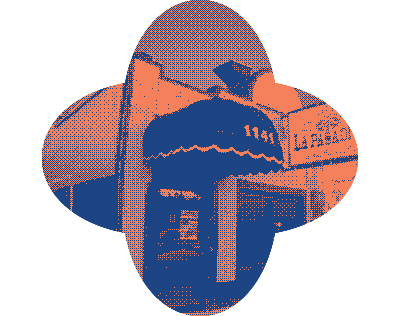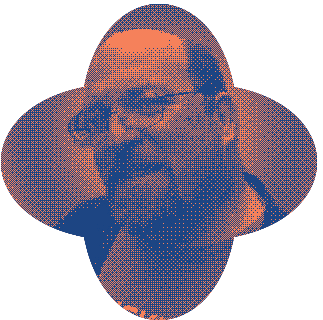

Before saying goodbye to this iconic software, we sat down with the SAIC alums who first helped developed it.
by Olivia Canny


Marc Canter transferred from Oberlin College to SAIC in 1978, arriving with a synthesizer that he had hand-built from a kit: The Serge Modular Music System. This is back when synthesizers were a completely new technology, he says. But back then, the lower level of the 280 Building was filled with equipment for making video art. SAIC students could get their hands on a Sandin Image Processor, a video synthesizer invented just a few years earlier by Chicago’s own Daniel Sandin. When Canter saw it, his first instinct was to take the patch from his music synthesizer and plug it into the video synthesizer.
At this moment, at the dawn of multimedia, he rethought the labels “musician” and “artist,” dubbing them old-fashioned terms. “Now we make music with our paintbrush, we paint with a violin,” he remembers saying. “That’s called a computer.”
Canter was raised in Chicago, but after about a year and a half at SAIC, he transferred back to Oberlin because the traditional art school required courses didn’t appeal to him. He spent some time in New York City building computers and programming laser light shows, returned home to UIC for graduate school, worked for Bally/Midway Manufacturing — an allegedly Chicago-mob-run company that built an empire from pinball machines — and then co-founded what he said was the first multimedia software company, ever, out of an old storefront near Diversey and Sheffield. He lived in the back of the building with his wife and kept the street-side lively with a staff of creative programmers and marketing workers.
MacroMind was the brainchild of Canter, the pioneering arcade game programmer Jamie Fenton, and SAIC alum Mark Stephen Pierce. Their plan was to develop tools specialized for Macintosh computers, which entered the market in 1984, the same year of the company’s launch. From the beginning, MacroMind’s software turned computers into a means for creativity. Their first product was a combined video and graphics editor, but they also made software specifically for making digital music compositions, and eventually, Director, the predecessor of Flash.
Paul Hertz, who formerly taught programming and new media art history at SAIC, was working on his MFA at the school through 1985, a time in which he says there was a big culture of people making work involving computers. When MacroMind came out with an early version of this software, then called VideoWorks, Hertz got to see the fruits of the product.
At that point, Silicon Valley just had Atari. Everything else, Canter says, was happening in Chicago.

“It was all in black and white,” he remembers. “And there was an animation of La Pasadita out on Ashland Ave where the developers used to like to go for taquitos.” Behind the restaurant, the dark outline of a mountain with ridges highlighted in white; in front, a street with the same grassy median that divides Ashland, and a Coupe De Ville whose driver wears a black gambler hat. The scene’s fine details are a bitmap of intricate gradients.
In the animation, someone enters La Pasadita, walks out and then explodes — “from the intense heat, supposedly,” says Hertz.
VideoWorks became Director, which was pretty affordable when it hit the market, Hertz remembers. He would go on to help develop later versions of the software. But early on, Director had its own plugin architecture, Shockwave, that let users make and distribute their projects offline — Canter says Director is responsible for 85 percent of the world’s CD-ROMS — or, users could bring their work to the internet. Director’s tools allowed these projects to be fairly complex, but they required a lot of bandwidth to operate online.
And back then, as Canter points out, “the web was like sucking data through a straw.”
Director didn’t have much competition for about a decade, until a similar software called FutureSplash entered the picture. While Director used heavier, bitmapped graphics, this new software was vector-based and more compact — attributes that led to the development of Flash as we’ve known it in the years since. But its function was ultimately modeled after MacroMind’s Director and the Shockwave plugin, which eventually became interchangeable between the two. Either way, people had highly accessible options for exploring video graphics as both an art form and utility. And before long, venture capitalists had options too.
“There was an open environment before everything was big money,” Canter remembers, with a lot of room to push the intellectual envelope. MacroMind had its first growth spurt in Chicago, where a vibrant network of programmers, musicians, and graphic artists comprised a burgeoning new media arts scene.
Hertz was there, too. “I think the city was hospitable particularly to experimentation,” he says. At SAIC, Sonia Sheridan taught Xerox as an art medium. Glitch art was later born here. But Hertz also cites Chicago’s affordability as a factor. Low rent means extra income for funding creative projects. For Canter, it was a combination of the big names in video graphics — Daniel Sandin and Thomas DeFanti — along with the whole mobster pinball evolution as the elements that set Chicago apart. At that point, Silicon Valley just had Atari. Everything else, Canter says, was happening in Chicago.
As MacroMind expanded further into Chicago's Lakeview neighborhood, Canter started taking frequent trips to California, where the money was. “And then,” he says, “the venture capitalists came into my life and got us to move from Chicago to Silicon Valley.”
Mergers and acquisitions followed, and Canter left the building, but not by choice. When the offices moved to a new location, he arrived to work one day to find that there wasn’t a parking spot for him.
“My reputation was the dope-smoking CEO guy,” he says. “And as soon as the venture capitalists found out, they were like ‘we gotta get rid of this guy.’” This was in the early 1990s, and Steve Jobs had recently been pushed out of Apple.
After his departure, MacroMind became Macromedia, which then acquired Director’s aforementioned vector-based rival, rebranded the software as Flash, and then got bought out by Adobe in 2005. Flash, of course, went on to become a household name, but Director was still around, and Hertz worked on it as a developer. He says that when Adobe acquired it, they completely rebranded the software, raised the price tag and marketed it as an industrial training tool.
“I mean they tried to sell it that way and that pretty much killed it,” he remembers. “But it was also a really lively developer’s community — creative, funny, sociable.” He’s still on a listserv of developers who worked together decades ago.
While most commercial software development was male-dominated, Hertz remembers the Director community having more women, whose backgrounds were less in programming and more so in media production and animation. It’s an atmosphere that’s not a far cry from the new media arts landscape that developed in the early 1990s. Hertz recalls artists from all different mediums — video installation, systems, and conceptual art — arriving at computers in the same moment that the internet started expanding.
MacroMind became Macromedia, which then acquired Director’s aforementioned vector-based rival, rebranded the software as Flash, and then got bought out by Adobe in 2005.
“I think that brings about a situation where what we come to think of as ‘new media art’ is often a collaborative enterprise, a group of people,” he says. “Sort of the model that you had in video from the beginning. If you were doing anything beyond traditional video, you had to think about somebody to help you with the sound or to write the music or to perform it, people to do the cameras, people to do the directing. So that model becomes part of new media art, too.”
For Canter, the software itself is his art form. As he says, “software is the new rock and roll” — an analogy that might help us cope with the end of Flash. Bands break up, and technology becomes obsolete. But at the end of the day, experimentation breeds innovation, and this is a value that Hertz wants to emphasize in software instruction as it persists today.
“To turn away from the notion that your ultimate product should be hyper-realistic,” he says, “and think more about exposing the capabilities of the software itself or its underlying assumptions. The ways in which it can be made to malfunction are a really critical part of it.”
“At the very least,” Hertz continues, “you need to think, in working with art, of the nature of your tools. Because artists have already always been doing that.” f

Back Up

